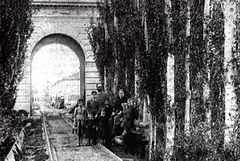Ferrocarril Puerto - Los Talas
| Puerto - Los Talas | ||||||||||||||||||||||||||||||||||||||||||||||||||||||||||||||||||||||||||||||||||||||||||||||||||||||
|---|---|---|---|---|---|---|---|---|---|---|---|---|---|---|---|---|---|---|---|---|---|---|---|---|---|---|---|---|---|---|---|---|---|---|---|---|---|---|---|---|---|---|---|---|---|---|---|---|---|---|---|---|---|---|---|---|---|---|---|---|---|---|---|---|---|---|---|---|---|---|---|---|---|---|---|---|---|---|---|---|---|---|---|---|---|---|---|---|---|---|---|---|---|---|---|---|---|---|---|---|---|---|
|
FCPLT workshop for the Decauville railways
| ||||||||||||||||||||||||||||||||||||||||||||||||||||||||||||||||||||||||||||||||||||||||||||||||||||||
|
Route map
| ||||||||||||||||||||||||||||||||||||||||||||||||||||||||||||||||||||||||||||||||||||||||||||||||||||||
| Route length: | 8.0 + 3.6 km | |||||||||||||||||||||||||||||||||||||||||||||||||||||||||||||||||||||||||||||||||||||||||||||||||||||
| Gauge : |
Broad gauge trunk line: 1676 mm Decauville feeder: 600 mm |
|||||||||||||||||||||||||||||||||||||||||||||||||||||||||||||||||||||||||||||||||||||||||||||||||||||
| Top speed: | 25 km / h | |||||||||||||||||||||||||||||||||||||||||||||||||||||||||||||||||||||||||||||||||||||||||||||||||||||
|
||||||||||||||||||||||||||||||||||||||||||||||||||||||||||||||||||||||||||||||||||||||||||||||||||||||
The Ferrocarril Puerto - Los Talas (FCPLT) ( Spanish Ramal a Los Talas ) was an 8 km long broad-gauge railway built in 1896 by the Urdaniz y Cía company in the Argentine province of Buenos Aires with a gauge of 1,676 mm (3 feet 6 inches ) with 3 , 6 km long narrow-gauge feeder lines with a gauge of 600 mm that connected the port of Puerto La Plata on the Río de la Plata with several quarries.
history

On July 14, 1896, the first freight train drove from the port to Los Talas . As early as February 4, 1897, the route was opened for general traffic of people and parcel post that had previously been transported on horses. In the same year, the government allowed the railroad to operate steam locomotives for freight, passenger and parcel post traffic on condition that Brazo signals were installed at the Los Talas station exit and junctions. Until then, the train was only allowed to travel 10 km / h, later it traveled at an average speed of 15 km / h and a top speed of 24 km / h.

In January 1901, the line was taken over by Ferrocarril del Sud , which it used until it was closed in 1910. The line was closed in 1910 due to the construction work on Avenida al Gran Río in La Plata, in which the embankment was breached. The tracks were dismantled in 1915 except for the first 150 m in the curve to the port of La Plata. Part of the stretch on the beach was still used for loading and unloading the cold stores in 1937.
Broad gauge railway
The trunk route led on the median of the old boulevard of Montevideo Avenue to today's Puente 3 de Abril , after which the route ran to the right of the avenue. At the level of Avenida Almirante Brawn , the line was relocated on the median of Avenida Montevideo , up to Daneri station , where the line turned left to go straight to Los Talas station.
Decauville Railways

There were several quarries in the area, in which mainly Schill limestone ( Conchilla in Spanish ) was mined. It is a mixture of shell limestone ( Coquina ) and Lumachella ( Lumaquela ). The main line was connected via Decauville feeder lines with several quarries for schill limestone, sand-lime brick and sand, as well as with agricultural and forestry companies for the extraction of firewood, fruit and vegetables, as their track sections in the quarries were much cheaper and easier to lay and maintain than the tracks of the broad-gauge railway. These Decauville railways had a repair shop operated by the FCPLT near the Los Talas train station, the building of which has been preserved to this day in very good condition.
remains
The Casa Martins , in which the cargo was packed and temporarily stored before being transported to the port, is still in very good condition. On a bridge on the Avenida Río de la Plata there are still Barrilon-type railway sleepers.


